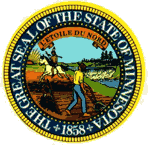 Higher Education in Minnesota
Higher Education in Minnesota
From urban to rural, big to small, public to private, Minnesota's colleges and universities offer you a variety of choices. Minnesota is home to more than 175 public and private higher education institutions serving more than 415,000 undergraduate and graduate students each year. Thirty-six of these institutions award graduate degrees.
In the 2008-2009 academic year, roughly 10,900 foreign-born students enrolled at Minnesota postsecondary institutions. Of these, 4,120 attend the University of Minnesota-Twin Cities, the state’s leading academic research institution. Minnesota was the 18th most popular destination in the United States for foreign-born students with China (1,617), India (1,139), Nepal (966), Republic of South Korea (929) and Canada (363) as the top countries of origin.About Minnesota
Minnesota is in the north central United States near the geographic center of North America, and is 575 kilometers west of Chicago. It gets its name from the Native American (Sioux) word minisota, meaning "water that reflects the sky”.
The state is known as the "Land of 10,000 Lakes" and is recognized for its abundant natural beauty, cultural attractions, recreational resources and thriving economy. People in Minnesota enjoy four seasons--sunny summers, beautiful autumn colors, snowy winters and lush green springs--and spend much time outdoors hiking, biking, canoeing, swimming, skiing, fishing and more. The Mississippi River begins its 2,500-mile journey at Lake Itasca in northern Minnesota; and Lake Superior, the world's largest freshwater lake, forms the northeast border of the state. Minnesota has more than 144,500 kilometers of shoreline: more than the states of California, Florida and Hawaii combined.
Minnesota is also known as the “North Star State,” a translation of the French inscription on the state seal, L'Etoile du Nord.
Minneapolis and St. Paul are Minnesota’s largest cities and are often referred to collectively as the “Twin Cities” since they border each other. The greater Twin Cities metropolitan area is the United States’ 16th largest metropolitan area according to the U.S. Census Bureau with more than half of Minnesota’s population living in the Twin Cities area. The Minneapolis/St. Paul International Airport (MSP) is among the busiest airports in the United States, serving 14 countries with direct non-stop service to and from Asia and Europe.
Although at least 75 percent of Minnesota's residents are of Western European descent (primarily German, Norwegian, Irish or Swedish), the last two decades have seen a substantial shift. The Hispanic population has increased dramatically and a significant number of immigrants from sub-Saharan Africa (Somali), Southeast Asia (Hmong and Vietnamese), India, and the former Soviet bloc now consider Minnesota home. According to the U.S. Census Bureau, 6.6 percent of Minnesota residents were foreign-born in 2008, compared to 12.5 percent for the nation as a whole.
Minnesota is known for its friendly people and is consistently ranked as one of the best places to live in the United States, including:
- 1st: Cleanest U.S. city, Minneapolis/St. Paul (Travel+Leisure Magazine, 2009)
- 1st: Healthiest U.S. state (CQ Press, 2009)
- 1st: Large city volunteer rate, Minneapolis/St. Paul (Corporation for National & Community Service, 2009)
- 1st: Most intelligent citizens, Minneapolis/St. Paul (Travel+Leisure Magazine, 2009)
- 1st: Best place to live, Plymouth (Money Magazine, 2008)
- 1st: Highest voter turnout, national election (George Mason University, 2008)
- 1st: Best air quality (Corporation for Enterprise Development, 2007)
- 1st: Best high school attainment (Corporation for Enterprise Development, 2007)
- 2nd: Best access to health care (Commonwealth Fund, 2009)
- 2nd: Overall child well being (Annie E. Casey Foundation, 2009)
- 2nd: Safest U.S. City, Minneapolis/St. Paul (Travel+Leisure Magazine, 2009)
- 2nd: Highest quality of life (Corporation for Enterprise Development, 2007)
- 3rd: Best U.S. Theater (Travel+Leisure Magazine, 2009)
- 3rd: State volunteer rate (Corporation for National & Community Service, 2009)
- 3rd: Highest earnings and job quality (Corporation for Enterprise Development, 2007)
- 4th: Most livable state (Morgan Quitno Press, 2008)
- 4th: Highest home ownership (Corporation for Enterprise Development, 2007)
- 5th: Cleanest world city, Minneapolis (Forbes, 2007)
- 5th: Friendliest U.S. City, Minneapolis/St. Paul (Travel+Leisure Magazine, 2009)
- 7th: Most sustainable U.S. city, Minneapolis (Sustainlane.com, 2008)
- 7th: Best college attainment (Corporation for Enterprise Development, 2007)
- 8th: Most energy efficient state (American Council for an Energy-Efficient Economy, 2009)
Business & Industry
The Minnesota economy has transformed over the last century from one based almost exclusively on agriculture and mining to a service and product-oriented economy. In addition to food products, Minnesota's manufacturers produce heath care and medical equipment, high technology such as electronic and computer equipment and scientific instruments, and forest products such as wood and paper. The state is also a leader in the finance and insurance industry and the printing and publishing industry. Many well-known companies began in Minnesota, including 3M, Imation, Best Buy, Medtronic, General Mills and Pillsbury.
Learn More About the State of Minnesota
